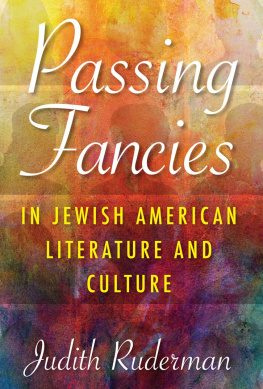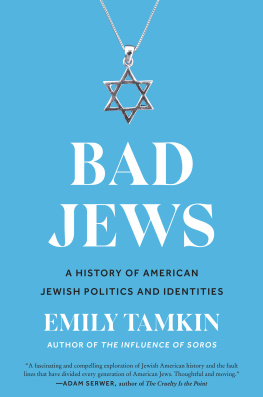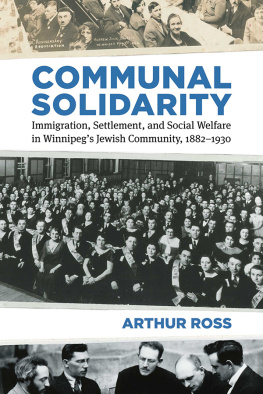Copyright 2020 by Princeton University Press
Requests for permission to reproduce material from this work should be sent to permissions@press.princeton.edu
Published by Princeton University Press
41 William Street, Princeton, New Jersey 08540
6 Oxford Street, Woodstock, Oxfordshire OX20 1TR
press.princeton.edu
All Rights Reserved
Library of Congress Cataloging-in-Publication Data
Names: Berman, Lila Corwin, 1976 author.
Title: The American Jewish philanthropic complex : the history of a multibillion-dollar institution / Lila Corwin Berman.
Description: Princeton : Princeton University Press, [2021] | Includes bibliographical references and index.
Identifiers: LCCN 2020018930 (print) | LCCN 2020018931 (ebook) | ISBN 9780691170732 (hardback) | ISBN 9780691209791 (ebook)
Subjects: LCSH: JewsUnited StatesCharitiesHistory. | Charity organizationUnited StatesHistory.
Classification: LCC HV3191 .B374 2021 (print) | LCC HV3191 (ebook) | DDC 361.7089/924073dc23
LC record available at https://lccn.loc.gov/2020018930
LC ebook record available at https://lccn.loc.gov/2020018931
Version 1.0
British Library Cataloging-in-Publication Data is available
Editorial: Fred Appel and Jenny Tan
Production Editorial: Leslie Grundfest
Jacket Design: Leslie Flis
Production: Erin Suydam
Publicity: Kate Hensley and Kathryn Stevens
Copyeditor: Karen Verde
Jacket Credit: Shutterstock
INTRODUCTION
The State of Philanthropy
A PORTION of my salary as a professor is paid out of an endowment, donated three decades ago by a small group of funders to my public university. My children attend a public magnet school with a rooftop garden, computers, and books contributed by corporations, businesses, and individuals. The local newspaper I read every morning is owned by a charitable foundation, the public radio station I tune in to reminds me on the hour that private family foundations support it, and my citys art museum is filled with galleries named after its supporters. Not a single day in my life passes untouched by philanthropy. The same is true for most Americans, whether they recognize it or not.
When I try to account for the scope of philanthropy in my life, I also have to acknowledge the particular contribution of Jewish philanthropy. Add to the above ledger my graduate education, multiple trips to Israel, my childrens first summer at Jewish overnight camp, hundreds of books I have read to them, and much more, all supported in entirety or large part through grants from Jewish private family foundations, community foundations, and public charities. The ubiquity of Jewish philanthropy in my life is also not unique. Almost any person who affiliates with an American Jewish community could make a similar accounting of the benefits they have reaped from Jewish philanthropy.
If I were to tally philanthropys contributions to my own life, I would confront a startlingly large figure. And if I were to try to calculate what proportion of that total figure could be classified as Jewish philanthropy, the sum would still be substantial, but the process of categorization would be riddled with unanswerable questions. When a Jewish family donates to an art museum, or endows a professorshipsuch as the one I holdfor the study of Jewish history at an American public university, is it engaging in Jewish philanthropy? Or when a non-Jewish family donates to a cause in Israel, is that Jewish philanthropy?
No wonder, then, that over the last decade, reports of the total value of American Jewish philanthropy have varied from $24 billion to $46.3 billion, depending on the criteria researchers use to define it. Even qualitative measures of American Jewish philanthropy run into similar problems, as researchers try to decide what makes an individual donate to a Jewish cause as opposed to an American one. Similarly, when investigative journalists probe the recesses of American Jewish philanthropy, they, too, confront these same definitional problems.
A historian of American Jewish philanthropy might feel pressed to define exactly what it is, a task that several other researchers have attempted. I wrote this book, however, because I think there is a better way to approach the topic. The more I have learned about American Jewish philanthropy, the more I have come to see that its significance has been grossly underestimated in blinkered attempts to account for it as distinct from American philanthropy or the American state.
When I began to explore the history of American Jewish philanthropy, I realized that it was leading me to examine the historical formation of the core ideologies of American democracy and capitalism. Never far below the surface of the institutions and practices of American Jewish philanthropy was a persistent puzzle of American statecraft: how to balance the interests of democracy with those of capitalism. Thus, to understand American Jewish philanthropy, I had to study the laws and policies that facilitated private means to act as a proxy for the public good. Over time, the institutions of the American state enriched private resources with public support. In squaring its obligations to a democratically empowered public and to capitalist growth, the state increasingly resolved that the good of the whole could be met best by not only freeing but, indeed, subsidizing private interests and markets. In this way, American democracy invested in capitalism. More than the sum of dollars and their donors and more than any rigid distinction between Jewish philanthropy and American philanthropy, what I have come to characterize as the American Jewish philanthropic complex emerged at the intersection of the American statethe laws, policies, agencies, officials, and practices that regulated the public good and protected private freedomsand Jewish communal aspirations in the United States.
A complex generally refers to something that brings together several parts into one formation, sometimes so successfully that we lose sight of its constituent pieces or its process of construction. This is exactly what I mean by the American Jewish philanthropic complex. With its beginnings in the nineteenth and early twentieth centuries and its full maturation over the second half of the twentieth century, it brought together the shifting terrain of American political economy and statecraft with the technical and psychological task of provisioning for American Jewish life. The partspolicies, political and economic ideologies, and cataclysmic events that reshaped global Jewish liferesolved into a complex, made to appear timeless and whole as much by the efforts of its institutions, leaders, and supporters as by its validation of late-twentieth-century American statecraft.
In 1961, during his last days in office, President Dwight Eisenhower delivered his now famous military-industrial-complex speech. In it he observed the ascendance of private interests (specifically, those of military producers) within government circles and public policies. He admonished that democratic principles would suffer should the trend continue. In this same period, a similar dynamic could be observed in the historical development of American philanthropy. Even with new regulatory measures enacted in the following decades, philanthropic institutions were nourished by and fostered an array of policies that empowered private entities to exercise governance over the American public. On one level, then, the American Jewish philanthropic complex was just one manifestation of an American philanthropic complex, which was simply a manifestation of the private control over public life about which Eisenhower had warned.






